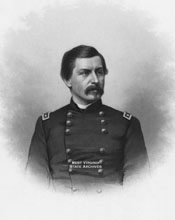 | Photograph, Major General George B. McClellan commanded Union forces in western (West) Virginia in 1861. He was given command of the Army of the Potomac due to his success in the Rich Mountain Campaign. Boyd B. Stutler Collection, West Virginia State Archives
|
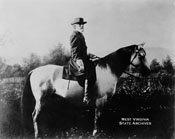 | Photograph, General Robert E. Lee was instrumental in capturing John Brown at Harpers Ferry in 1859. He commanded Confederate forces at Cheat Mountain and the ill-fated Sewell Mountain Campaign and earned the nickname "Granny" Lee for his failures in western (West) Virginia in 1861. Lee rose to prominence in 1862 during the Richmond Peninsular Campaign. West Virginia State Archives
|
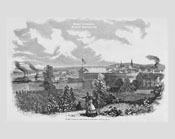 | Photograph, "Landing of Union Troops at Parkersburg, Western Virginia," Frank Leslie's Illustrated Newspaper, August 21, 1861. West Virginia State Archives
|
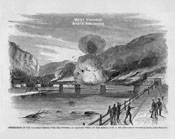 | Photograph, "Destruction of the Railroad Bridge over the Potomac, at Harper's Ferry, by the Rebels, June 15, 1861," Harpers Illustrated, July 6, 1861. West Virginia State Archives
|
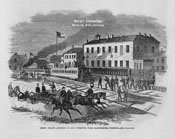 | Photograph, "Rebel Troops Arriving at and Departing from Martinsburg, Virginia," Harpers Illustrated, June 29, 1861. West Virginia State Archives
|
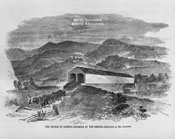 | Photograph, "The Battle of Romney - Skirmish at the Bridge," Harpers Illustrated, July 6, 1861. West Virginia State Archives
|
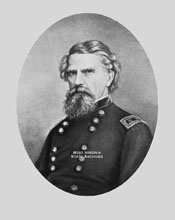 | Photograph, Colonel Benjamin F. Kelley raised and commanded the 1st (West) Virginia Infantry (3 months service) and fought in the battle of Philippi, where he was wounded. He was afterward promoted to brigadier general. Boyd B. Stutler Collection, West Virginia State Archives
|
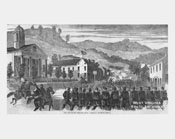 | Photograph, "The Battle of Philippi," Harpers Illustrated, July 6, 1861. West Virginia State Archives
|
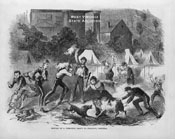 | Photograph, "Return of a Foraging Party to Philippi, Virginia," Harpers Illustrated, August 17, 1861. West Virginia State Archives
|
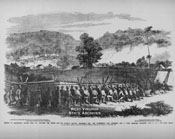 | Photograph, "Battle of Bealington [Belington], Laurel Hill, Va., between the Ninth and the Seventh Indiana Regiments and the Fourteenth Ohio Regiment, and a Rebel Georgian Regiment, July 8, at 5 P. M.," Frank Leslie's Illustrated Newspaper, July 20, 1861. West Virginia State Archives
|
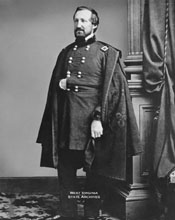 | Photograph, General William S. Rosecrans commanded the successful Federal troops at Rich Mountain and Carnifex Ferry and the unsuccessful Sewell Mountain Campaign. He succeeded McClellan as commander of Union troops in western (West) Virginia. West Virginia Education Association Collection, West Virginia State Archives
|
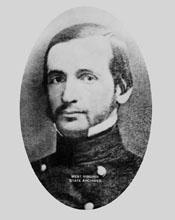 | Photograph, General Robert S. Garnett commanded Confederate troops at Rich Mountain and Laurel Hill, where he was forced to evacuate his positions. He was killed in a rear-guard skirmish on July 13, 1861, at Corrick's Ford (Parsons), becoming the first general killed in the Civil War. David Strahin Collection, West Virginia State Archives
|
 | Photograph, "The Advance of General Rosencranz's Division through the Forests of Laurel Hill, to Attack the Rebel Entrenchments at Rich Mountain," Frank Leslie's Illustrated Newspaper, August 31, 1861. West Virginia State Archives
|
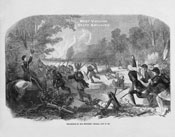 | Photograph, "The Battle of Rich Mountain, Virginia, July 13 [July 11], 1861," Harpers Illustrated, July 27, 1861. West Virginia State Archives
|
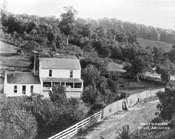 | Photograph, Hart House, Rich Mountain battlefield. West Virginia State Archives
|
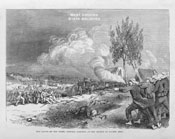 | Photograph, "The Death of the Rebel General Garnett, at the Battle of Laurel Hill [Corrick's Ford]," Frank Leslie's Illustrated Newspaper, August 3, 1861. West Virginia State Archives
|
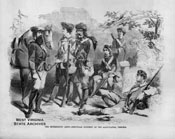 | Photograph, "The Secessionist Army - Irregular Riflemen of the Alleghanies, Virginia," Harpers Illustrated, July 20, 1861. West Virginia State Archives
|
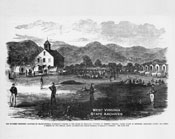 | Photograph, "The Southern Prisoners Captured by Major-General M'Clellan's Column in the Series of Brilliant Victories in Western Virginia, under Guard at Beverley, Randolph County, Va.," Frank Leslie's Illustrated Newspaper, August 17, 1861. West Virginia State Archives
|
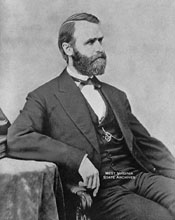 | Photograph, General Jacob D. Cox commanded Union troops in the Kanawha Valley that occupied Charleston following clashes at Barboursville and Scary Creek. He worked in tandem with General William S. Rosecrans during the Carnifex Ferry and Sewell Mountain campaigns. Boyd B. Stutler Collection, West Virginia State Archives
|
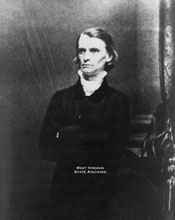 | Photograph, General Henry A. Wise, who was a former governor of Virginia, was given command of all Confederate troops in the Kanawha Valley and surrounding region. He became embroiled in a feud over seniority of command with General John B. Floyd while in western (West) Virginia. Boyd B. Stutler Collection, West Virginia State Archives
|
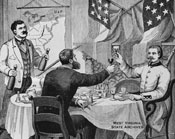 | Photograph, Pryce Lewis was a Union spy employed by Allan Pinkerton to infiltrate Confederate camps in the Kanawha Valley. Although successful, his information arrived too late to be of any consequence. He is seen here with Captain George S. Patton at Camp Tompkins near St. Albans. West Virginia State Archives
|
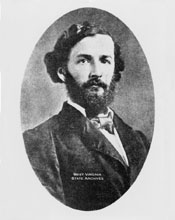 | Photograph, Colonel George S. Patton commanded Confederate troops on the field at the battle of Scary Creek on July 17, 1861, where he was wounded and captured. He was the grandfather and namesake of General George S. Patton of World War II fame. Boyd B. Stutler Collection, West Virginia State Archives
|
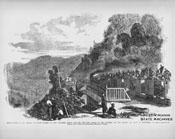 | Photograph, "Transportation of Col. Irvine's Sixteenth Regiment of Ohio Volunteer Militia over the Tray Run Viaduct on the Baltimore and Ohio Railway, En Route to Rowlesburg, Va.," Frank Leslie's Illustrated Newspaper, August 3, 1861. West Virginia State Archives
|
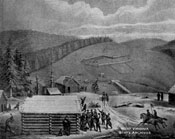 | Photograph, Camp and fort at Cheat Mountain, 1861. Boyd B. Stutler Collection, West Virginia State Archives
|
 | Photograph, "Rowlesburg, the Head-Quarters of General Hill, in Western Virginia," Harpers Illustrated, August 3, 1861. West Virginia State Archives
|
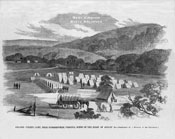 | Photograph, "Colonel Tyler's Camp, near Summersville, Virginia, Scene of the Fight of August 26," Harpers Illustrated, September 14, 1861. West Virginia State Archives
|
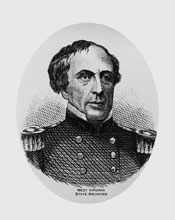 | Photograph, General John B. Floyd, former governor of Virginia and United States Secretary of War, commanded Confederate troops at the battles of Kesler's Cross Lanes and Carnifex Ferry in Nicholas County. He became embroiled in a feud over seniority of command with General Henry A. Wise while in western (West) Virginia. Boyd B. Stutler Collection, West Virginia State Archives
|
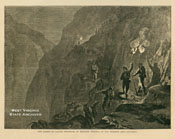 | Photograph, "The Ascent of Gauley Mountain, in Western Virginia by the Twelfth Ohio Regiment," Harpers Illustrated, October 5, 1861. West Virginia State Archives
|
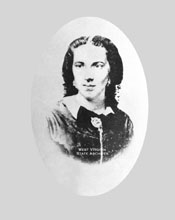 | Photograph, Belle Boyd, a noted Confederate spy from Martinsburg, shot and killed a Union soldier outside her home in July 1861. West Virginia State Archives
|
Some of the best-known images of the war in western Virginia undoubtedly were drawn by Corporal J. Nep. Roesler, Company G (Color Guard), 47th Ohio Volunteer Infantry. His series of possibly twenty-two lithographs (only twenty have been found), etched on stone, of the regiment's activities in the vicinity of Gauley Bridge, Carnifex Ferry, Hawks Nest, and Fayetteville rank among the best, and most recognizable, scenes of the 1861-62 western Virginia campaign.
John Nep. Roesler (also spelled Rosler, Rossler, and Roessler) was born circa 1826 in Baden, Germany. At the time of the Civil War, he was a resident of Cincinnati, Ohio, where he enlisted on June 15, 1861, in Company H, 47th Ohio Volunteer Infantry. His occupation at that time was "artist." Roesler first served as a corporal in Company H and then as a corporal in Company G. He was discharged for disability on February 8, 1862, at Gauley Mount, (West) Virginia, and given a surgeon's certificate of disability at Cincinnati on September 29, 1862, for the loss of his left eye. After returning home in 1862, he sketched lithographs of his military experiences in western Virginia. Originally sketching on stone, Roesler later mass-produced his images and sold them to returning veterans. After the war he supposedly travelled the mountains of West Virginia selling the prints. The original stones were reportedly used in his home garden in Cincinnati.
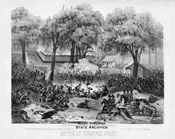 | Photograph, "Battle At Carnifax Ferry," sketch by J. Nep. Roesler. West Virginia State Archives
|
 | Photograph, "March to the Landing," sketch by J. Nep. Roesler. West Virginia State Archives
|
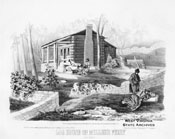 | Photograph, "Log House on Miller's Ferry, Camp Anderson," sketch by J. Nep. Roesler. West Virginia State Archives
|
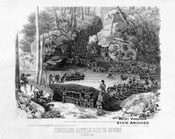 | Photograph, "Crossing Little Birch River to Bulltown," sketch by J. Nep. Roesler. West Virginia State Archives
|
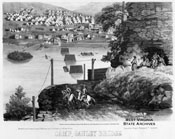 | Photograph, "Camp, Gauley Bridge," sketch by J. Nep. Roesler. West Virginia State Archives
|
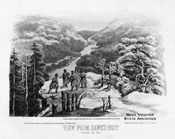 | Photograph, "View from Hawks Nest towards the East," sketch by J. Nep. Roesler. West Virginia State Archives
|
 | Photograph, "Thunder-Storm (Big Sewell Mountain) (Reconnoissance)," sketch by J. Nep. Roesler. West Virginia State Archives
|
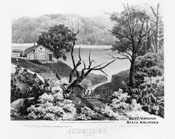 | Photograph, "Skirmishing, New River," sketch by J. Nep. Roesler. West Virginia State Archives
|
 | Photograph, "Pickets on the Road from Camp Anderson to Tompkins Farm," sketch by J. Nep. Roesler. West Virginia State Archives
|
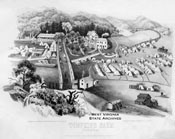 | Photograph, "Tompkins Farm (Camp Gauley Mount)," sketch by J. Nep. Roesler. West Virginia State Archives
|
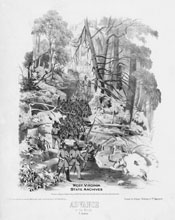 | Photograph, "Advance in the Woods, Camp Anderson," sketch by J. Nep. Roesler. West Virginia State Archives
|
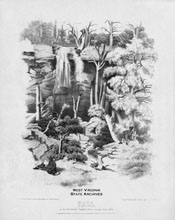 | Photograph, "Fall on the Road between Tompkins Farm & Gauley Bridge," sketch by J. Nep. Roesler. West Virginia State Archives
|
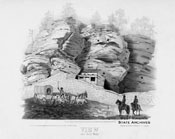 | Photograph, "View near Gauley Ferry," sketch by J. Nep. Roesler. West Virginia State Archives
|

